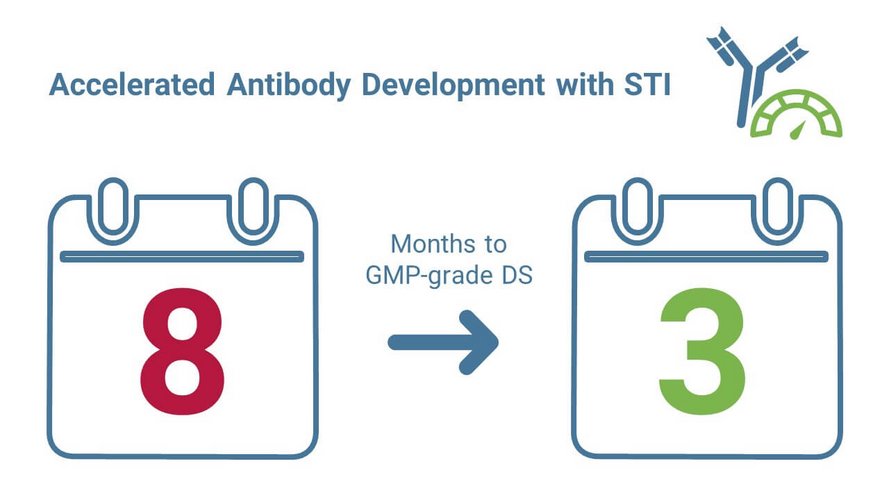A Step towards “Warp Speed” Development of GMP-Grade Antibody-Based Therapeutics for Clinical Studies
June 24, 2022
Marie-Ange Kouassi
Biotherapeutic development timelines need to be shortened to bring critical medicines to patients faster without compromising efficacy and safety. One limiting step involved is the time-consuming, complex, and tedious cell line development process. This stage which involves genetic engineering lengthens development times as it requires extensive screening to ensure cell lines exhibit superior characteristics and generate the intended safe product. Currently, it can take 16-24 months to reach the clinical stage but by applying innovative engineering approaches and digital technology such as Genedata Selector®, biopharma companies can significantly accelerate drug time-to-market.
The recent COVID-19 pandemic has demonstrated the necessity for biopharmaceutical companies to streamline biotherapeutic development processes to meet the urgent health needs of patients. Typically, the development of biotherapeutics such as monoclonal antibodies (mAbs), involves the use of recombinant cell lines. These cells are genetically engineered using random transgene integration (RTI), a technique used to introduce genetic information into the host cell genome for the generation of specific monoclonal antibodies. However, it is not without shortcomings, for example, RTI is time-consuming, error-prone, and involves complex analysis and selection processes hence prolonging development timelines until GMP-grade drug substance (DS) is available for clinical research. At Boehringer Ingelheim, Schmieder et al. investigated transposase-mediated semi-targeted transgene integration (STI) as an alternative to RTI. They found that STI significantly accelerated the development of a stable pool cell line which resulted in the rapid production of high-quality drug substance in less than 3 months. For the first time in the biopharma industry, clinical trials were able to commence only 6 months following transfection of the production cell line (rather than 16 or 24 months) putting Boehringer Ingelheim in good stead for efficient, successful clinical development.
Schmieder et al. transfected Boehringer Ingelheim’s proprietary CHO host cell system with a transposase-based dual vector system (semi-targeted transgene integration, STI). For this, the Leap-In I transposase mRNA and a transposon vector containing the expression cassette for a mAb1 heavy chain (HC), the corresponding light chain (LC) genes, and a selection marker were used. This approach allows the integration of the expression construct into defined transposase recognition sites in transcriptionally active regions, allowing for a high expression of the envisioned constructs. Further, it is predicted that transposon-mediated integration creates less genetic and phenotypic heterogeneity.
Following electroporation, stable CHO cell pools were generated by growth in selection media. The stability and productivity of these pools were analyzed using fed-batch cultivation and shake flask culture. The variability observed among the different pools was very low and one of the stable pools was selected to produce early drug substance and GMP-grade clinical product at up to 2000 L scale.

Regulatory agencies require clonal cell lines for long-term production of DS which should guarantee stability and safety of the production process and the product itself. FACS and cold capture surface staining were used to clone stable mAb1-producing monoclonal cells using one stable pool as the starting material. Single-cell growth and monoclonality were assessed by fluorescence microscopy and mAb productivity (recombinant protein concentration) with bio-layer interferometry. An advanced microbioreactor system was used to assess bioprocess performance.
Product quality (PQ) attributes such as recombinant product purity was then determined using size-exclusion chromatography. In addition to phenotypic stability tests, the CHO cell pools and established cell clones were genetically characterized using digital droplet (ddPCR) and RNA sequencing for sequence variant analysis. The resulting data was analyzed using Genedata Selector.
Schmieder et al. identified that the substrates produced by cell pools derived from STI were homogenous as they exhibited a lower level of inter-pool variation and higher specific productivity than mini pools derived using RTI. On the other hand, pools generated from STI exhibited reduced cell growth. A stable pool generated using STI was assessed and selected to produce early drug substance material supply and GMP-grade clinical material at 2,000 L scale. The PQ attributes of mAbs generated by the stable pool(s) were comparable indicating that the STI pool was indeed robust. Using RNA sequencing, the authors could not detect any transcript variants confirming the integrity of the STI pool cell line.
The generated single-cell clones originating from the stable pool demonstrated increased productivity in generating mAb1 compared to the parental pool. However, the antibodies produced had comparable PQ attributes and cell lines were confirmed as phenotypically stable, however, exhibited variation in genomically inserted transgene copies. As no mutations were found above the limit of detection, the clones were indeed confirmed as genetically stable comparable to the parental pools. Characteristics of material produced by the clones such as purity, charge heterogeneity, and N-glycan pattern were compared. Schmieder et al. also identified that the characteristics of the clones were more consistent than those of the parental pool.
Biopharmaceutical institutions increasingly recognize the need to optimize processes and embrace new technologies to accelerate the delivery of safe therapeutics to patients. For the first time, GMP-grade drug substance was generated at an unprecedented, accelerated pace using site-directed (targeted) transgene integration (STI). Schmieder et al. demonstrated that STI-generated stable CHO cell pools enable reproducible production processes which result in accelerated development of GMP-grade drug substance ready for clinal studies.
Genedata Selector, an advanced enterprise platform that simplifies and automates NGS data processing and analysis, allowed in-depth genetic characterization of the cell pool and monoclonal cell line, a cornerstone of a thorough cell line development process. The platform also provided clear go/no-go signals and facilitated seamless exploration of the supporting data for data-informed decision-making. Biopharma companies can leverage Genedata Selector to streamline overall production processes and confirm key product characteristics such as efficacy, safety, integrity, and stability from beginning to end stages. This is key to ensuring that cell lines and their derivative products meet regulatory expectations of proof and documentation, essential for market approval. To learn more about this study, read the publication.